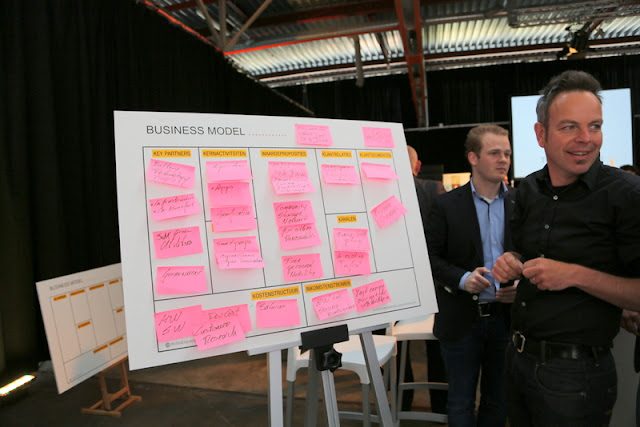Building on the shoulders of Giants
These last two
decades have been totally disrupted by the Internet. There isn't a business
that hasn't been affected. And the virtual connectivity as well as cheap access
to powerful technology has also affected the way companies innovate. Most of us
are walking around with several thousand times more computing power than NASA
used to send a man to the moon in 1969. The so-called Apollo Guidance
Computer (AGC) used a real time operating system had approximately 64 kilobyte
of memory and operated at a speed if 0.043 MHz.
The AGC had a
miniscule memory....
It feels as if
the speed of disruptive change is no longer linear. But it is logarithmic.
8 comes next to four instead of 5.
End User
Innovation - Early Business Model Canvas?
The
late Peter F. Drucker, the Austrian-born management consultant, is often
credited with explaining how larger manufacturers innovated in the past.
Basically they locked themselves away in secret labs, developing products they
could patent and then sell to the public or other businesses. As the world
becomes more connected, this is becoming harder and harder to do.
Meanwhile, along
came the notion of End-user innovation. A person or a small company
develops an innovation for their own use because existing products or services
don't meet their needs. Access to powerful computers as well as cheap hardware
has made it possible for brilliant companies to start in the back of a garage,
often funded by personal savings.
In 1988, MIT economist Eric
von Hippel identified end-user innovation as, by far, the most important
and critical in his classic book on the subject "Sources of Innovation" now available for free download.
In addition, the
famous robotics engineer Joseph F. Engelberger asserted that
innovations require only three things:
1. A recognized
need,
2. Competent
people with relevant technology, and
3. Financial
support.
The
Kline Chain-linked model of innovation places great emphasis on
potential market needs as drivers of the innovation process. It also describes
the complex and often iterative feedback loops between marketing, design,
manufacturing, and R&D.
To use this sounds like very early thinking that we know call the Business Model Canvas.
Adapting these
ideas to 2013
Jed Cristiansen
is an American living in London. He's raced solar-powered cars across the
Australian outback, operated nuclear reactors and US Navy submarines, been a
consultant, and currently works for Google.
 |
| Jed Cristiansen |
In 2009, he wrote
an extensive paper outlining how people could copy Y combinator, the successful accelerator program that kicked things off in Silicon Valley. It's
inspired us to build a more focussed program in the South of the Netherlands.
The report is an extensive analysis, but draws relatively simple
conclusions.
To be a continued
successful seed accelerator program, you need to have a financial model that
works, provide value to the companies that you invest in, and invest in the
best possible companies. That means the best possible companies need
to prefer your program to any other.
Jed now runs Seed-Database
which monitors the successes of the Accelerator community. That turns out to be
around 169 different programs, most of which are still in business.





































